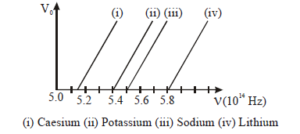All electron ejected from a surface by incident of wavelength 200 nm can be stopped before
travelling 1 meter in the direction of a uniform electric field of 4 NC–¹ the work function of the
surface is :-
No solution provided for this question.
All electron ejected from a surface by incident of wavelength 200 nm can be stopped before
travelling 1 meter in the direction of a uniform electric field of 4 NC–¹ the work function of the
surface is :-
No solution provided for this question.
The ratio of momenta of an electron and α-particle which are accelerated from rest by a
potential difference of 100 V is :-
No solution provided for this question.
When monochromatic radiation of intensity I falls on a metal surface, the number of photoelectron and their maximum kinetic energy are N and T respectively. If the intensity of radiation is 2I, the number of emitted electrons and their maximum kinetic energy are respectively :- (Assume frequency of radiation to be constant)
No solution provided for this question.
The threshold frequency for a photosensitive metal is \[3.3\times 10^{14} Hz\]. If light of frequency \[8.2\times 10^{14} Hz\] is incident on this metal, the cut-off voltage for the photoelectric emission is nearly :-
No solution provided for this question.
A 200 W sodium street lamp emits yellow light of wavelength 0.6 μm. Assuming it to be 25%
efficient in converting electrical energy to light, the number of photons of yellow light it emits per second is :-
No solution provided for this question.
When photons of energy hv fall on an aluminium plate (of work function E0), photoelectrons of
maximum kinetic energy K are ejected. If the frequency of the radiation is doubled, the
maximum kinetic energy of the ejected photoelectrons will be :-
No solution provided for this question.
When a point source of monochromatic light is at a distance of 0.2 m from a photoelectric cell,
the cut-off voltage and the saturation current are 0.6 volt and 18 mA respectively. If the same
source is placed 0.6 m away from the photoelectric cell, then :-
No solution provided for this question.
The figure shows different graphs between stopping potential (V0) and frequency (n) for
photosensitive surface of caesium, potassium, sodium and lithium. The plots are parallel. Correct ranking of the targets according to their work function, greatest first, will be :-

No solution provided for this question.
The energy that should be added to an electron to reduce its De broglie wavelength from
\[10^{-10}m\] to \[0.5\times 10^{-10}m\] m will be :
No solution provided for this question.
The velocity of the most energetic electrons emitted from a metallic surface is doubled when
the frequency v of the incident radiation is doubled. The work function of this metal is :-
No solution provided for this question.